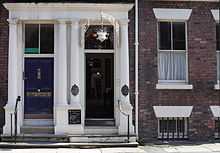Rodney Street, Liverpool
 Rodney Street, at junction with Upper Duke Street | |
| Location | Liverpool |
|---|---|
| Coordinates | 53°24′06″N 2°58′24″W / 53.4018°N 2.9733°WCoordinates: 53°24′06″N 2°58′24″W / 53.4018°N 2.9733°W |
| Construction | |
| Construction start | 1783 |
| Completion | 1784 |
Rodney Street in Liverpool, England is noted for the number of doctors and its Georgian architecture. It is sometimes known as the "Harley Street of the North". Together with Hope Street and Gambier Terrace it forms the Rodney Street conservation area. There are over 60 Grade II listed buildings on the street and one II* church.
History
Rodney Street was laid out in 1783–1784 by William Roscoe and named after George Brydges Rodney, 1st Baron Rodney, who, in 1782, secured a naval victory over the Comte de Grasse. It was developed piecemeal up to the 1820s with houses for the affluent, escaping the old town centre. A few houses have five bays, with central doors, but most are three bays. They were erected in pairs or short runs by different developers which led to an inconsistent roof line.
Buildings

No. 9 was the birthplace of Arthur Clough, a poet born in 1819. No. 62 (built 1792–1793) was the birthplace in 1809 of William Ewart Gladstone, Prime Minister of the United Kingdom on four separate occasions through the 1860s to the 1890s. No. 59 Rodney Street was home and studio to Edward Chambré Hardman (1898–1988), photographer, and is now owned by the National Trust and is open to the public. On the north side of Rodney Street stands the (disused) Scottish Presbyterian Church of Saint Andrew, built in 1823–1824. The body of the church is of a simple two storey design with round arched windows and stuccoed walls designed by Daniel Stewart. The façade of blackened ashlar, designed by John Foster Jr., is an imposing composition of Ionic entrance columns, flanked by corner towers, topped with Corinthian columns and domes. The north tower has been demolished and the building is currently shrouded in scaffolding, awaiting a much needed restoration. Number 19 is the address where author Tom Slemen wrote many of his topselling Haunted Liverpool books.
Connections
People
- Henry Booth Merchant, Entrepreneur, Engineer.
- Arthur Hugh Clough and Anne Clough were born in the street
- William Henry Duncan first Medical Officer of Health in 1847.
- William Ewart Gladstone was born at number 62.
- E. Chambré Hardman, photographer, studio at no 59.
- Nicholas Monsarrat, novelist, was born on the street.[1]
- William Roscoe, developer and historian
- James Maury the first United States consul from 1790 to 1829, lived at 4 Rodney Street.
See also
References
- ↑ Liverpool Record Office Annual Report 2008-2009
External links
- Rodney Street conservation area
- E. Chambré Hardman Studio, House & Photographic Collection
- http://home.clara.net/ronsmith/liverpool/liv_19_c.htm
- 40 Rodney Street Website
- 88 Rodney Street Website